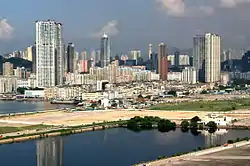Ma Tau Wai
Ma Tau Wai (Chinese: 馬頭圍, originally 碼頭圍,[1] historically 古瑾圍) is an area in the Kowloon City District, Kowloon, Hong Kong.[2][3] It was originally a walled village (Cantonese: Wai) between present-day Argyle Street and Prince Edward Road West, east of present-day St. Teresa's Hospital.[4]

The area of Ma Tau Wai is not as well-defined as the original village, as the geographic features have been lost. The Ma Tau Wai Road in To Kwa Wan does not pass through Ma Tau Wai proper, although it was originally intended to. Ma Tau Wai is sometimes referred to the area south of Argyle Street and north of To Kwa Wan.
The public housing estate Ma Tau Wai Estate is named after the area / the original village.
Collapse of building at 45 Ma Tau Wai Road (2010)

On 29 January 2010, Block J of 45 Ma Tau Wai Road, a rundown five-storey residential building, collapsed with little warning, resulting in the deaths of four people. The event took place at around 1:30pm. Renovation work was being carried out on the commercial unit located on the ground floor of the building, when construction workers noticed signs of an imminent collapse and rushed out to raise the alarm. It is speculated that the unauthorised renovation was the primary factor that led to the collapse of an already decaying and structurally weak building. Some of the residents were alerted by the commotion and evacuated seconds before the entire building caved in. A squad of fireman arrived at the scene just as the disaster unfolded, having received an emergency call from a passer-by prior to the collapse. Several hundred emergency workers were deployed in the ensuing rescue operation, which had to take place under adjacent buildings that were themselves subject to collapse at any moment. Temporary reinforcements were erected to support and stabilise the remaining structures to give added protection to the rescue teams.
The Chief Executive Donald Tsang later visited the site to inspect the rubble.
A repair order had been issued by the authorities months before, but at the time of the inspection, the extent of the symptoms did not indicate the gravity of the situation. The walk-up building, which was 55 years old, was the last block in a group of ten identical buildings. Each floor housed four apartments of around 150 square feet (14 square metres), which in some cases were further partitioned by their owners. Residents in the adjoining blocks were subsequently relocated to temporary shelters in the immediate aftermath and then on to interim housing at public estates. This type of building is typical of many over the territory.
Implications and further action
The case was the first of its type in several decades, and raised new awareness amongst the public of the potential dangers faced by residents of such buildings. A thorough investigation into this particular incident, as well as a plan to prevent similar cases from occurring was ordered by the Government. The approximately four thousand buildings of the same classification that were constructed before 1960 were subsequently earmarked for inspection within one month.[5][6]
The Urban Renewal Authority later announced development of the other blocks in the row.[7]
Other landmark of the areas
Hong Kong's Notre Dame College is in Ma Tau Wai.
New Asia College, one of three founding colleges of the Chinese University of Hong Kong, was located near Tin Kwong Road and Farm Road. After the college moved to Ma Liu Shui, Sha Tin, New Asia Middle School was founded at the former campus.
See also
References
- 劉健宇 (21 January 2021). 馬頭圍得名竟然唔關「馬」事. Stand News (in Chinese). Retrieved 25 January 2021.[in English?]
- "Kowloon City - HungHom" (PDF). e-HongKongGuide 2020. Hong Kong: Lands Department. 14 January 2020. Retrieved 24 January 2021.
- 2018香港大地圖 [Complete City Guide of Hong Kong 2018] (in Chinese). Wan Li Book.
- 蕭險峰; 岑智明; 劉國偉 (15 April 2016). 九龍城「上帝古廟」原址考證 (PDF). Fieldwork and Documents: South China Research Resource Station Newsletter (in Chinese) (83): 13. ISSN 1990-9020.[in English?]
- Govt press release re. investigation report on the collapse, 26 April 2010
- Fatal collapse due to `external forces' Archived 2012-10-15 at the Wayback Machine, The Standard, April 27, 2010
- URA commences the Ma Tau Wai Road/Chun Tin Street project with special measures Archived 21 June 2011 at the Wayback Machine, Urban Renewal Authority, 24 February 2010
External links
| Wikimedia Commons has media related to Ma Tau Wai. |
- Report on the Collapse of the Building at 45J Ma Tau Wai Road … on 29 January 2010, HKG Buildings Dept.